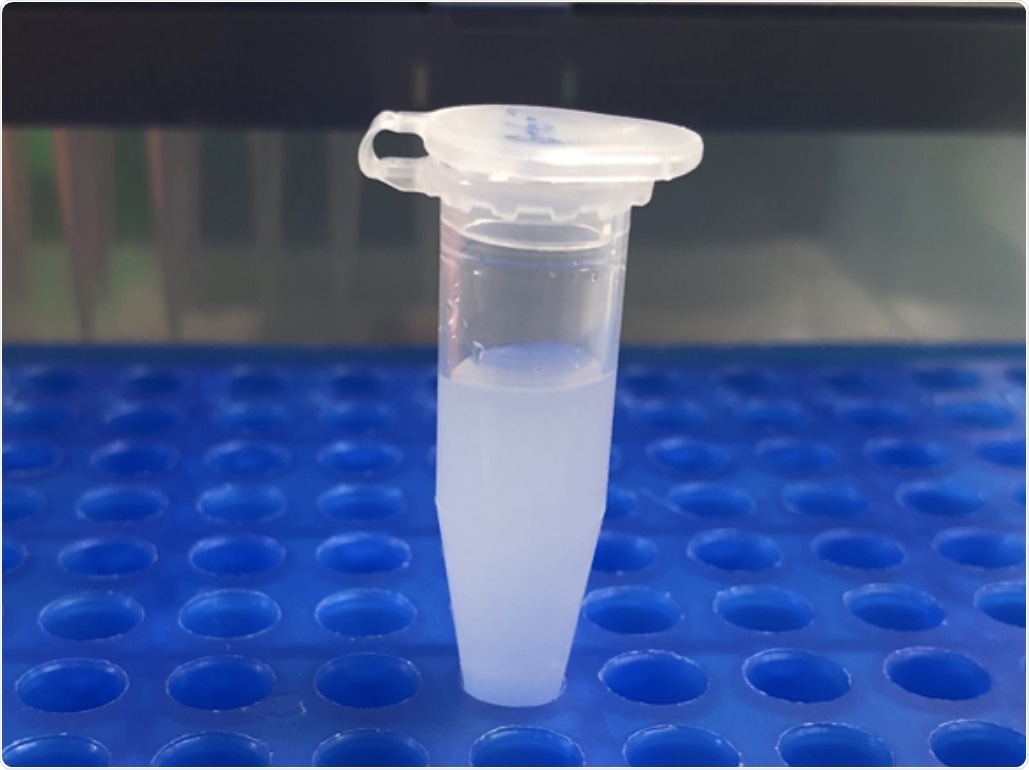Scientists from Hokkaido University, Japan, developed and tested a library of lipid-based compounds for the safe and effective delivery of RNA drugs to the lungs.

A suspension of lipid nanoparticles synthesized from the novel lipomer AA03-DL-10. Image Credit: Takuya Isono.
The findings published in the Materials Horizons journal identified a lipid polymer that can be employed to treat pulmonary hypertension, acute respiratory distress syndrome, and lung cancers in the future.
The COVID-19 pandemic response accustomed people to RNA vaccines that carry genetic code into cells to induce the production of virus proteins that activate our protective immunity. RNA drugs are exhibiting excellent potential in treating numerous other diseases by directing protein production inside cells, without the need for deleting or inserting DNA. However, researchers face many challenges in the safe delivery to targeted cells.
One successful yet complex technique involves carrying the RNA codes inside nanoparticles covered with compounds, called targeting ligands, that bind to specific cells. This process was successful in targeting liver cells.
Pharmaceutical scientist Hideyoshi Harashima and polymer chemist Toshifumi Satoh from Hokkaido University headed a group of scientists in creating and testing a library of ε-decalactone-based compounds, lipids that can bypass the liver—which degrades toxins and foreign substances—and specifically deliver RNA code into the lungs. Harashima was recently laurelled the Høst-Madsen Medal, the highest scientific honor awarded by The International Pharmaceutical Federation (FIP).
The researchers worked with two closely related ring-shaped compounds—ε-decalactone and ε-caprolactone. Lipid nanoparticles (NPs) comprising these lactones were earlier shown to accumulate in the lungs. They underwent ring-opening reactions with one of 11 amino alcohols. The resultant product was further classified based on the molecular weight of each arm.
The products were combined with mRNA and another compound called DMG-PEG to create mRNA-carrying NPs. NPs created from ε-caprolactone were unstable, hence the researchers carried on with the NPs from ε-decalactone.
The researchers examined the delivery of RNA-carrying ε-decalactone NPs first into laboratory cancer cells and then intravenously into mice. They employed mRNA encoding enhanced green fluorescence protein (EGFP) to determine the NPs’ destination. Eventually, the researchers identified that ε-decalactone combined with linear amino alcohol called AA03 generated better results.
The analysis made clear that NPs containing the lipomer were able to largely bypass the liver and carry the RNA material specifically into the lungs. The cell membrane engulfs the NPs and the RNA content gets released into the lung cell cytoplasm.
We showed that expanding the chemical space of smart materials could enable the fabrication of nanoparticles for hard-to-reach targets without the need for targeting ligands. Designing combinatorial libraries that provide diverse ε-decalactone lipomers could be an easy and scalable strategy for the development of next-generation gene therapies for organs beyond the liver.”
Hideyoshi Harashima, Pharmaceutical Scientist, Hokkaido University
Source:
Journal reference:
Abd Elwakil, M. M., et al. (2021) Engineered ε-decalactone lipomers bypass the liver to selectively in vivo deliver mRNA to the lungs without targeting ligands. Materials Horizons. doi.org/10.1039/D1MH00185J.